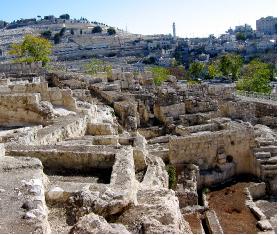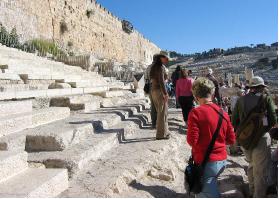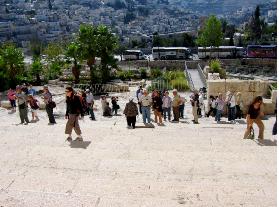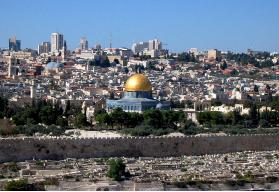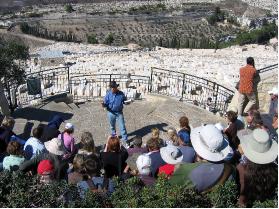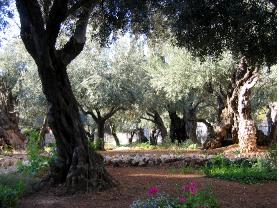 |
|
Israel Journal COLLEEN TINKER |
||||
NUMBER 11 — FRIDAY, NOVEMBER 7, 2008
The temple steps, Mt. of Olives, Gethsemane, and Peter's denial of Jesus
Ohmygoodness!! Today was over the top—at least it ended over the top! I’ll try to share it with you—it’s actually been really fun for me to journal these days; it helps me process what I’ve experienced and integrate my thoughts and feelings. Sometimes it seems as if it’s not quite “real”—there are so many “impossible” experiences and reactions, and I sometimes feel like a spectator, or like I’m on a grand field trip!
We started the day at 8:00 as usual—and our first appointment was seeing the excavated steps of the temple on the South Wall. The walls we now see surrounding the Temple Mount were built in the 16th century; they are not original. The south gate stairs, however, were unearthed only within the last 15 years.
It’s interesting to realize that the temple mount is on Mt. Moriah. Mt. Moriah was the place where Abraham offered Isaac and was provided with the substitutionary ram. Fast forward to David. David wanted to build a permanent place of worship; consequently, he bought a threshing floor from a farmer; that piece of land was Mt. Moriah on which Solomon built the first temple.
Herod the Great had built the temple that was in use when Jesus was here. When Jesus said, destroy this temple, and in three days he would rebuild it—He was talking about His own body. Jesus is the new temple. He is where sin has been dealt with; within His own body one sacrifice has bee made for all time.
We sat on the recently excavated steps of the South Wall of the temple, and we realized that Jesus had without doubt walked up and down those very steps. I was quite overcome as I realized that as Jesus walked up those steps toward the temple about 2,000 years ago, HE KNEW that all the sacrifices and rituals going on around Him actually represented HIM. He knew He was here to make that beautiful temple obsolete. Moreover, He knew that from the foundation of the world, all of us who know Him were “in Him” even then. He knew that today we would be on those temple steps, and He knew all of us who love Him were alive in Him eternally.
What an amazing experience to sit and stand on those ancient steps and to know that we were where Jesus had certainly been—and to know that even then He knew us!
Mount of Olives
Next we went to the Mt of Olives. The view of Jerusalem from the Mount of Olives is unbelievable and breathtaking. Jerusalem is very hilly, and the Mt of Olives is directly east of the temple. Directly below the Mount of Olives is the largest Jewish cemetery in the world; the hill continues down from the cemetery into the Kidron Valley; then it begins to go up, and it culminates on the temple Mount.
I had never understood how beautiful Jerusalem is. Even when I saw pictures, I thought of Jerusalem as being essentially in a desert; on the contrary, the climate is Mediterranean, and while it is not overly wet, still there are many olive trees, pine trees, and other vegetation to make the city lovely with trees. The Mount of Olives is where Jesus taught his disciples to pray; this is where His triumphal entry into Jerusalem began; this is where he sat and wept over Jerusalem.
Gary talked to us about Jesus’ prophecies in Matthew 24 regarding the end of the age which He declared from the Mount of Olives. Moreover, he read from Zechariah 14 where the prophet foresees a time when the Lord will come and fight for His people. When he appears, the Mount of Olives will be split into two sections: east and west. The Lord will reign over His people, and living waters will flow from the throne to water the eastern (Dead) sea and the western (Mediterranean) sea. The Lord will be king of all the earth.
We walked down from the Mount of Olives to the bottom of the hill, following the path Jesus followed on His triumphal entry. On the way down the hill we stopped at a tiny Greek Orthodox church, a beautiful gem with a view of Jerusalem from it’s west apse. We all stood under the vaulted domed ceiling and sand “Amazing Grace”. It was beautiful; many sang parts, and the reverberation in that church was several seconds. The sound was ethereal.
Gethsemane
After lunch we went to the Garden of Gethsemane. Rather unexpectedly, this stop was a highlight for many of us. First of all, the garden itself is beautiful. Whether or not it is the exact spot where Jesus agonized, it is very near it. Beautifully tended, the garden is full of olive trees of all ages. The oldest ones are probably about 2,000 years old.
While we waited outside the Byzantine-era Church of the Agony or Church of the Nations, Gary spoke to us about Jesus in Gethsemane. Jesus did not die the way many of His followers died. They died in triumph, knowing they would soon see their Lord. Jesus, however, died in fear. For the first time in eternity, He would be looked on by His Father as the object of His wrath and anger. All the horrors of hell would be on Him. He knew what was ahead.
Further, Gethsemane was the only time in His life that He asked for others to come and help him—He asked Peter, James, and John especially to watch and pray with Him. His agony as He became sin for us (2 Corinthians 5:21) was only duplicated when he cried from the cross, “My God, my God, why have you forsaken me?”
But the Father restored Him. He took our place and paid the price of our sin, and if we accept Him we will never have to pay that price of sin. And not only has He paid our price; we have new promises. Romans 8 declares there is now no condemnation for those who are in Christ Jesus.
Gethsemane more than anything else shows us what Jesus endured. He took the cup and drank it to the bottom. Hebrews 5 tells us that in the days of His flesh, Jesus offered prayers with tears to Him who was able to save Him from death. He was heard because of His reverence.
Yet we know Jesus did die. God did hear his prayer—but, as Gary said, sometimes God’s “no” only requires a resurrection to make it a “yes”.
Gary went on to point out that the one moment when everything in Jesus said “No,” He didn’t say it. As a Son, He learned obedience, and being made perfect by His obedience, He became the source of eternal salvation. The word “perfect” connotes being fully qualified. If He hadn’t come to the point of saying “Yes” in spite of suffering, He wouldn’t have qualified to undo what Adam did.
As we sat in the gem-like, tiny cathedral, the Church of the Agony, our group sang “I Come To the Garden Alone” and one verse of “How Great Thou Art”. Everyone was already deeply moved by the overwhelming sense of Jesus being crushed by sin and experiencing His Father’s wrath so we could be free. The singing was perhaps the best we had ever done; the harmony was beautiful, and everyone’s emotion made the music rich with feeling; the dome reverberated with the offering of all our hearts.
Peter's denial
Our final stop was at the traditional site commemorating Peter’s denial of Jesus. The church is built upon what might have Caiaphas’ house. Whether or not it is, the Roman-era stone stairway nearby, called “La Scala Sacra”, or The Sacred Stairs, is certainly the stairway up which Jesus was led following His arrest as He was taken before Caiaphas for his illegal, nighttime hearing. The stairway is steep and uneven, and the thought of Jesus being brutally treated as He began His relentless move to the cross became vivid as I actually saw the setting and the stairway up which He had been made to climb to His humiliation and death.
I’ll put up a second post describing the end of our day. We love you all, and we’re praying for you.
Thankful beyond words for Jesus and the Father’s love.
Copyright 1999-2008 Graphics Studio, Redlands, CA USA. All rights reserved. Revised November 17, 2008. Use of this site and forum signifies your acceptance of the Terms and Conditions. Send comments and questions to formeradventist@gmail.com
